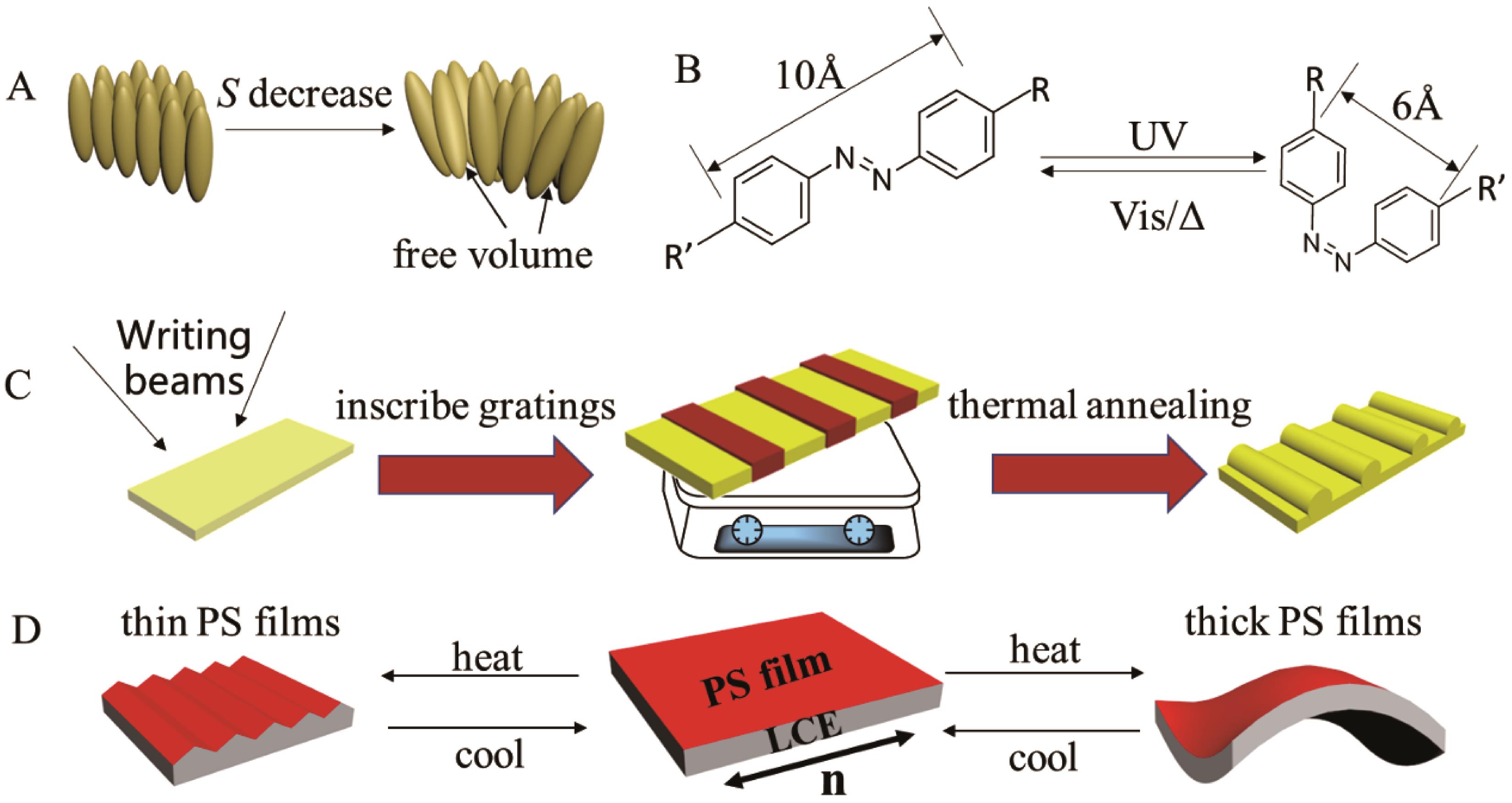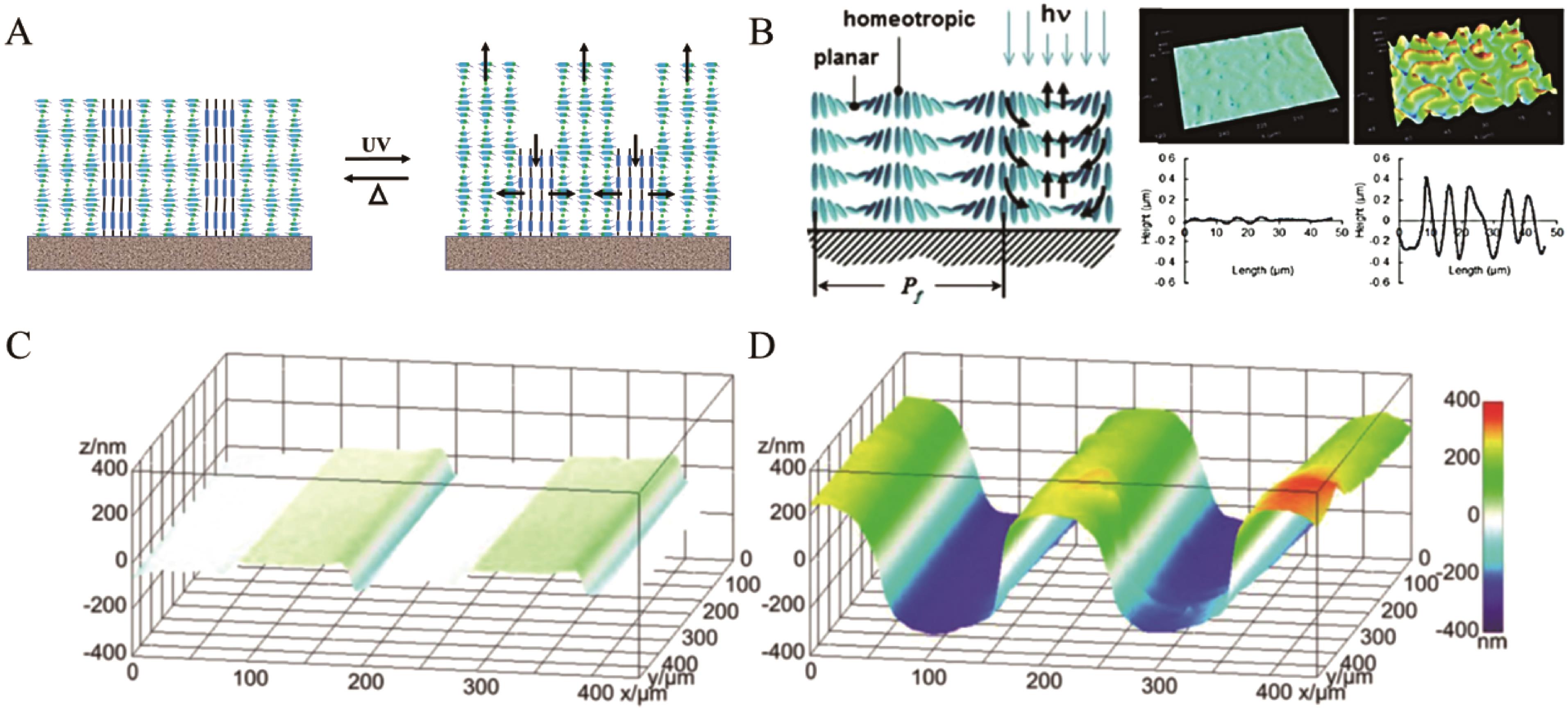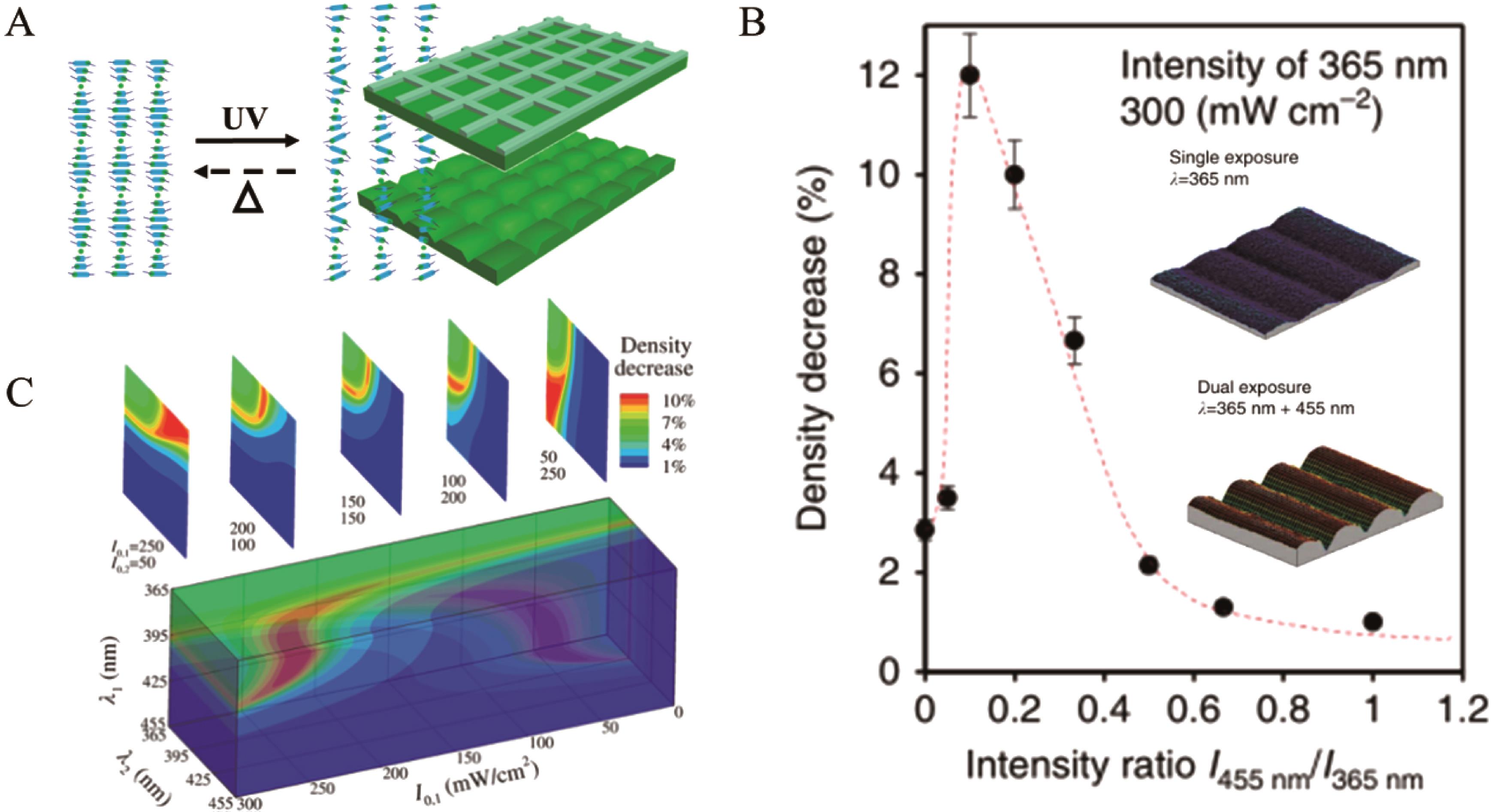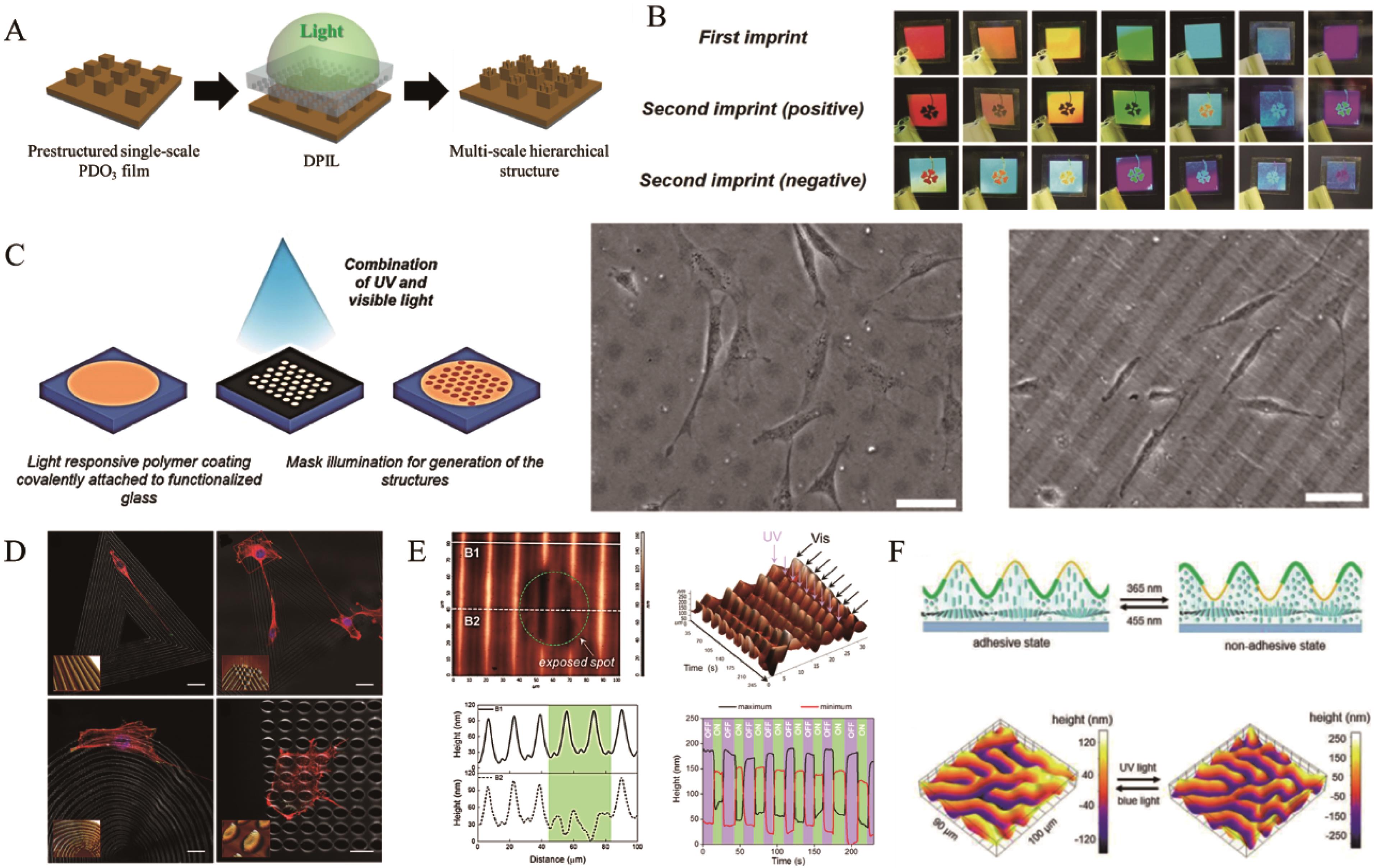
应用化学 ›› 2021, Vol. 38 ›› Issue (10): 1226-1237.DOI: 10.19894/j.issn.1000-0518.210381
液晶聚合物的表面形貌光调控研究进展
- 北京大学材料与科学工程学院与教育部高分子化学与物理重点实验室,北京 100871
-
收稿日期:2021-07-30接受日期:2021-08-26出版日期:2021-10-01发布日期:2021-10-15 -
通讯作者:于海峰 -
基金资助:国家自然科学基金(51773002)
Research Progress on Photoswitchable Surface Topography of Liquid Crystalline Polymer
Yu-Fan JI, Feng CAI, Hai-Feng YU( )
)
- School of Materials Science and Engineering,and Key Laboratory of Polymer Chemistry and Physics of Ministry of Education,Peking University,Beijing 100871,China
-
Received:2021-07-30Accepted:2021-08-26Published:2021-10-01Online:2021-10-15 -
Contact:Hai-Feng YU -
About author:yuhaifeng@pku.edu.cn
-
Supported by:National Natural Science Foundation of China(51773002)
摘要:
光响应液晶聚合物具有良好的自组装特性与光调控性能,被广泛地应用于表面微纳结构的研究中。通过改变液晶分子的取向方式和有序参数,可以得到复杂多样的表面形貌,这在光学、生物学和机械控制等领域有较高的研究价值与应用前景。表面形貌调控的关键在于对其机理的深刻理解与把握:从液晶分子指向矢的角度来说,当液晶分子的有序参数减小时,会沿指向矢方向收缩,垂直指向矢方向膨胀,利用相邻域之间分子取向差异产生的侧向剪应力,可以构建具有表面起伏的微纳结构;从液晶聚合物产生自由体积的角度来说,紫外光照射时产生的自由体积会使薄膜密度下降,在偶氮苯可逆的反-顺-反异构化的动态过程中,会形成宏观表面起伏;从光诱导聚合物质量迁移的角度来说,光场的光强分布、偏振态以及光束的波前均会对材料的定向质量迁移产生影响;从光照使薄膜表面稳定性改变的角度来说,可以利用光聚合时薄膜的各向异性收缩产生褶皱,也可以通过应力释放对薄膜的表面褶皱形貌进行调控。因此,基于光诱导产生表面形貌变化的4种不同机理,对光控表面形貌的相关研究进展进行了回顾和总结,并展望了未来可能的发展方向,为后续进一步研究液晶聚合物的表面形貌调控及其功能化提供了参考。
中图分类号:
引用本文
纪宇帆, 蔡锋, 于海峰. 液晶聚合物的表面形貌光调控研究进展[J]. 应用化学, 2021, 38(10): 1226-1237.
Yu-Fan JI, Feng CAI, Hai-Feng YU. Research Progress on Photoswitchable Surface Topography of Liquid Crystalline Polymer[J]. Chinese Journal of Applied Chemistry, 2021, 38(10): 1226-1237.

图 1 (A)液晶分子有序参数降低引起的变化; (B)偶氮苯的光致异构化转变; (C)表面起伏光栅的形成过程; (D)双层膜的两种失稳模式
Fig.1 (A) The change induced by the decreased order parameter; (B) Photo-isomerization of azobenzene; (C) The formation process of surface relief gratings; (D) Two instability modes of bilayer membrane

图 2 (A)平面取向和垂直取向交替排列的LCN涂层。紫外光照射后,平面取向的分子在垂直平面方向膨胀,垂直取向的分子在垂直平面方向收缩;(B)包含指纹图案的LCN涂层。紫外线照射前和照射时表面形貌的干涉仪测量图像[40];玻璃基底(C)和柔性聚合物基底(D)的LCN涂层表面形貌变化[41]
Fig.2 (A) LCN containing chiral nematic and homeotropic orientation. After ultraviolet (UV) illumination, the chiral nematic areas expand perpendicular to the plane of the film while the homeotropic areas contract in the perpendicular direction; (B) LCN including fingerprint patterns. Images from interferometer measurements showing the surface topography before and during UV irradiation[40]; Topographical deformation of LCN coatings with (C) rigid glass and (D) a compliant polymer layer as the substrate[41]

图 3 (A)利用掩模进行紫外光照射后,自由体积的产生导致LCN密度降低的示意图;(B)在365和 455 nm双波长照射时,表面变形增加[21];(C)在任意波长的两束光照射下实现光机械响应最大化的设计模型[45]
Fig.3 (A) Illustration of the reduced LCN density after UV illumination with photomasks due to the generation of free volume; (B) Under the illumination of 365 and 455 nm light, surface topographical deformation is increased[21]; (C) Design box for maximizing the optomechanical response under two-light illumination with arbitrary wavelengths[45]

图 4 线偏振光(A) 和圆偏振光(B)产生的表面起伏[49];(C)q值对螺旋图案的影响的示意图,q=10(D)和q=-10(E)L-G光束所得图案的光学显微照片和原子力显微镜(AFM)图像(所有比例尺均为1 μm[51]);聚合过程中利用二向色性染料(F)和二向色性引发剂(G)调控表面形貌
Fig.4 (A,B) Surface reliefs resulting from linearly (A) and circularly (B) polarized beams[49]; (C) Scheme of the influence of q value on spiral pattern; (D,E) Optical micrograph and AFM image of the pattern of q=10 (D) and q= -10 (E) L-G beam. All the scale bars are 1 μm[51]; (F,G) Manipulation of surface topography using dichroic dye (F) and dichroic initiator (G) during polymerization

图 5 无(A)和有(B)436 nm 线偏振光照射时表面形貌的光学显微照片;(C)含有偶氮苯光引发剂的紫外光固化 LCP 薄膜在 PDMS 表面形成宏观褶皱的示意图[56] ,单轴压缩方向平行(D)和垂直(E)条纹图案时,紫外光照射下褶皱形貌的光学显微照片[57]; (F)多循环系统中刺激诱导的褶皱产生、光诱导的褶皱调控和擦除[58]
Fig.5 Optical microscopic images of the surface topography without (A) and with (B) 436 nm linearly polarized light irradiation; (C) Scheme of the macroscopic wrinkle formation of the PDMS surface by the UV-curable LCP film containing azobenzene-containing photoinitiator[56]; Optical microscopic images of wrinkle topography under UV illumination when uniaxial compression is parallel (D) and perpendicular (E) to the line pattern[57]; (F) Multiple cycles of stimulus-induced wrinkling, light-induced tuning and erasing in the optically wrinkling system[58]

图 6 (A)制造复杂的分层多级结构的过程示意图; (B)压印图案的结构色照片[65]; (C)光响应LCE涂层的表面形貌变化示意图和NIH-3T3细胞在有呈六边形排列的0.2 μm高的柱子和0.3 μm高的圆形图案的LCN表面的相衬度图像(比例尺为50 μm)[67]; (D)在pDR1m表面图案上的细胞取向,包括沿边、顶点、同心圆环和点阵列4种图案(比例尺为10 μm[68]); (E)HH-垂直结构处于紫外光稳态并局部照射绿光时的表面形貌的AFM图像以及表面波可发生在持续的紫外光与绿光交替照射下[69]; (F)通过光触发的表面形貌变化,粘接状态发生改变的示意图以及光刺激过程中表面起伏反转的三维数字全息显微镜照片[70]
Fig.6 (A) Schematic illustration of the fabrication of complex hierarchical multilevel structures; (B) Structural color images of imprinted nanopatterns[65]; (C) Schematic process of the surface topography change on the light-responsive LCE coatings and phase contrast images of NIH-3T3 cells on patterned LCN in hexagonally arranged pillars of 0.2 μm height and a circular pattern with a height of 0.3 μm. Scale bars are 50 μm[67]; (D) Cell orientation on confocal-induced pDR1m patterns including the geometry along the sides, on the vertex, on concentric rings and on array of dots. Scale bars are 10 μm[68] ; (E) AFM images of surface topography of the HH-perpendicular structure which is UV photostationary state and locally exposed to green light. Surface waving happens under the continuous UV illumination and alternative green light[69] ; (F) Schematic illustration of the switch of adhesion via light-triggered topographical deformation and 3D digital holographic microscopic images of the surface topographical inversion during the light stimulation process[70]
| 1 | OSCURATO S L, BORBONE F, MADDALENA P, et al. Light-driven wettability tailoring of azopolymer surfaces with reconfigured three-dimensional posts[J]. ACS Appl Mater Interfaces, 2017, 9(35): 30133-30142. |
| 2 | LIU D Q, TITO N B, BROER D J. Protruding organic surfaces triggered by in-plane electric fields[J]. Nat Commun, 2017, 8: 1526. |
| 3 | FENG W, BROER D J, LIU D Q. Oscillating chiral-nematic fingerprints wipe away dust[J]. Adv Mater, 2018, 30(11): 1704970. |
| 4 | VISWANATHAN N K, KIM D Y, BIAN S P, et al. Surface relief structures on azo polymer films[J]. J Mater Chem, 1999, 9(9): 1941-1955. |
| 5 | NATANSOHN A, ROCHON P. Photoinduced motions in azo-containing polymers[J]. Chem Rev, 2002, 102(11): 4139-4175. |
| 6 | FUKUDA T, MATSUDA H, SHIRAGA T, et al. Photofabrication of surface relief grating on films of azobenzene polymer with different dye functionalization[J]. Macromolecules, 2000, 33(11): 4220-4225. |
| 7 | VISSCHERS F L L, HENDRIKX M, ZHAN Y Y, et al. Liquid crystal polymers with motile surfaces[J]. Soft Matter, 2018, 14(24): 4898-4912. |
| 8 | LIU D, BROER D J. Liquid crystal polymer networks: switchable surface topographies[J]. Liq Cryst Rev, 2013, 1(1): 20-28. |
| 9 | FENG W, LIU D, BROER D J. Functional liquid crystal polymer surfaces with switchable topographies[J]. Small Struct, 2021, 2(1): 2000107. |
| 10 | LIU D Q, BASTIAANSEN C W M, DEN TOONDER J M J, et al. (Photo-)Thermally induced formation of dynamic surface topographies in polymer hydrogel networks[J]. Langmuir, 2013, 29(18): 5622-5629. |
| 11 | WANG Z, HANSEN C, GE Q, et al. Programmable, pattern-memorizing polymer surface[J]. Adv Mater, 2011, 23(32): 3669-3673. |
| 12 | KONG X, WANG X, LUO T, et al. Photomanipulated architecture and patterning of azopolymer array [J]. ACS Appl Mater Interfaces, 2017, 9(22): 19345-19353. |
| 13 | YANG B, YU M, YU H. Azopolymer-based nanoimprint lithography: recent developments in methodology and applications[J]. ChemPlusChem, 2020, 85(9): 2166-2176. |
| 14 | TURIV T, KRIEGER J, BABAKHANOVA G, et al. Topology control of human fibroblast cells monolayer by liquid crystal elastomer[J]. Sci Adv, 2020, 6(20): eaaz6485. |
| 15 | LIU L, BROER D J, ONCK P R. Travelling waves on photo-switchable patterned liquid crystal polymer films directed by rotating polarized light[J]. Soft Matter, 2019, 15(40): 8040-8050. |
| 16 | MEHTA K, PEEKETI A R, LIU L, et al. Design and applications of light responsive liquid crystal polymer thin films[J]. Appl Phys Rev, 2020, 7(4): 041306. |
| 17 | HIKMET R A M, BROER D J. Dynamic mechanical properties of anisotropic networks formed by liquid crystalline acrylates[J]. Polymer, 1991, 32(9): 1627-1632. |
| 18 | VAN OOSTEN C L, HARRIS K D, BASTIAANSEN C W M, et al. Glassy photomechanical liquid-crystal network actuators for microscale devices[J]. Eur Phys J E, 2007, 23(3): 329-336. |
| 19 | MOL G N, HARRIS K D, BASTIAANSEN C W M, et al. Thermo-mechanical responses of liquid-crystal networks with a splayed molecular organization[J]. Adv Funct Mater, 2005, 15(7): 1155-1159. |
| 20 | TANCHAK O M, BARRETT C J. Light-induced reversible volume changes in thin films of azo polymers: the photomechanical effect[J]. Macromolecules, 2005, 38(25): 10566-10570. |
| 21 | LIU D Q, BROER D J. New insights into photoactivated volume generation boost surface morphing in liquid crystal coatings[J]. Nat Commun, 2015, 6: 8334. |
| 22 | HUGEL T, HOLLAND N B, CATTANI A, et al. Single-molecule optomechanical cycle[J]. Science, 2002, 296(5570): 1103-1106. |
| 23 | HOLLAND N B, HUGEL T, NEUERT G, et al. Single molecule force spectroscopy of azobenzene polymers: switching elasticity of single photochromic macromolecules[J]. Macromolecules, 2003, 36(6): 2015-2023. |
| 24 | LI C, CAO L, LI J, et al. Improvement of volume holographic performance by plasmon-induced holographic absorption grating[J]. Appl Phys Lett, 2013, 102(6): 061108. |
| 25 | BRUDER F K, HAGEN R, RÖLLE T, et al. From the surface to volume: concepts for the next generation of optical⁃holographic data-storage materials[J]. Angew Chem Int Ed, 2011, 50(20): 4552-4573. |
| 26 | CHO Y H, SHIN C W, KIM N, et al. High-performance transmission holographic gratings via different polymerization rates of dipentaerythritol acrylates and siloxane-containing epoxides[J]. Chem Mater, 2005, 17(25): 6263-6271. |
| 27 | GOLDENBERG L M, SAKHNO O V, SMIRNOVA T N, et al. Holographic composites with gold nanoparticles: nanoparticles promote polymer segregation[J]. Chem Mater, 2008, 20(14): 4619-4627. |
| 28 | YU H F, OKANO K, SHISHIDO A, et al. Enhancement of surface-relief gratings recorded on amphiphilic liquid-crystalline diblock copolymer by nanoscale phase separation[J]. Adv Mater, 2005, 17(18): 2184-2188. |
| 29 | AN N, LI M E, ZHOU J X. Instability of liquid crystal elastomers[J]. Smart Mater Struct, 2016, 25(1): 015016. |
| 30 | SONI H, PELCOVITS R A, POWERS T R. Wrinkling of a thin film on a nematic liquid-crystal elastomer[J]. Phys Rev E, 2016, 94(1): 012701. |
| 31 | ROFOUIE P, PASINI D, REY A D. Nano-scale surface wrinkling in chiral liquid crystals and plant-based plywoods[J]. Soft Matter, 2015, 11(6): 1127-1139. |
| 32 | SONG S E, CHOI G H, YI G R, et al. Competitive concurrence of surface wrinkling and dewetting of liquid crystalline polymer films on non-wettable substrates[J]. Soft Matter, 2017, 13(42): 7753-7759. |
| 33 | KANG S H, NA J H, MOON S N, et al. Self-organized anisotropic wrinkling of molecularly aligned liquid crystalline polymer[J]. Langmuir, 2012, 28(7): 3576-3582. |
| 34 | AGRAWAL A, YUN T, PESEK S L, et al. Shape-responsive liquid crystal elastomer bilayers[J]. Soft Matter, 2014, 10(9): 1411-1415. |
| 35 | ZHAO S, XU F, FU C, et al. Controllable wrinkling patterns on liquid crystal polymer film/substrate systems by laser illumination [J]. Extreme Mech Lett, 2019, 30: 100502. |
| 36 | LIU X, LIU Y. Spontaneous photo-buckling of a liquid crystal elastomer membrane[J]. Int J Mech Sci, 2021, 201: 106473. |
| 37 | ZHAO J, YU Y, XU P, et al. Wrinkling of liquid-crystal elastomer disks caused by light-driven dynamic contraction[J]. Phys Rev E, 2021, 103(4): L041002. |
| 38 | LIU D Q, BASTIAANSEN C W M, DEN TOONDER J M J, et al. Photo-switchable surface topologies in chiral nematic coatings[J]. Angew Chem Int Ed, 2012, 51(4): 892-896. |
| 39 | BROER D J, MOL G N. Anisotropic thermal-expansion of densely cross-linked oriented polymer networks[J]. Polym Eng Sci, 1991, 31(9): 625-631. |
| 40 | LIU D Q, BROER D J. Self-assembled dynamic 3D fingerprints in liquid-crystal coatings towards controllable friction and adhesion[J]. Angew Chem Int Ed, 2014, 53(18): 4542-4546. |
| 41 | HENDRIKX M, SIRMA B, SCHENNING A P H J, et al. Compliance-mediated topographic oscillation of polarized light triggered liquid crystal coating[J]. Adv Mater Interfaces, 2018, 5(20): 1800810. |
| 42 | HENDRIKX M, SCHENNING A P H J, BROER D J. Patterned oscillating topographical changes in photoresponsive polymer coatings[J]. Soft Matter, 2017, 13(24): 4321-4327. |
| 43 | EISENBACH C D. Effect of polymer matrix on the cis⁃trans isomerization of azobenzene residues in bulk polymers[J]. Makromol Chem, 1978, 179(10): 2489-2506. |
| 44 | LIU D Q, BASTIAANSEN C W M, DEN TOONDER J M J, et al. Light-induced formation of dynamic and permanent surface topologies in chiral-nematic polymer networks[J]. Macromolecules, 2012, 45(19): 8005-8012. |
| 45 | LIU L, ONCK P R. Enhanced deformation of azobenzene-modified liquid crystal polymers under dual wavelength exposure: a photophysical model[J]. Phys Rev Lett, 2017, 119(5): 057801. |
| 46 | ROCHON P, BATALLA E, NATANSOHN A. Optically induced surface gratings on azoaromatic polymer-films[J]. Appl Phys Lett, 1995, 66(2): 136-138. |
| 47 | KIM D Y, TRIPATHY S K, LI L, et al. Laser-induced holographic surface-relief gratings on nonlinear-optical polymer-films[J]. Appl Phys Lett, 1995, 66(10): 1166-1168. |
| 48 | OSCURATO S L, SALVATORE M, MADDALENA P, et al. From nanoscopic to macroscopic photo-driven motion in azobenzene-containing materials[J]. Nanophotonics, 2018, 7(8): 1387-1422. |
| 49 | BIAN S, LI L, KUMAR J, et al. Single laser beam-induced surface deformation on azobenzene polymer films[J]. Appl Phys Lett, 1998, 73(13): 1817-1819. |
| 50 | BIAN S, WILLIAMS J M, KIM D Y, et al. Photoinduced surface deformations on azobenzene polymer films[J]. J Appl Phys, 1999, 86(8): 4498-4508. |
| 51 | AMBROSIO A, MARRUCCI L, BORBONE F, et al. Light-induced spiral mass transport in azo-polymer films under vortex-beam illumination[J]. Nat Commun, 2012, 3: 989. |
| 52 | AMBROSIO A, MADDALENA P, MARRUCCI L. Molecular model for light-driven spiral mass transport in azopolymer films[J]. Phys Rev Lett, 2013, 110(14): 146102. |
| 53 | FENG W, BROER D J, GREBIKOVA L, et al. Static and dynamic control of fingerprint landscapes of liquid crystal network coatings[J]. ACS Appl Mater Interfaces, 2020, 12(5): 5265-5273. |
| 54 | YANG D, HE L H. Photo-triggered wrinkling of glassy nematic films[J]. Smart Mater Struct, 2014, 23(4): 045012. |
| 55 | YANG D, HE L H. Nonlinear analysis of photo-induced wrinkling of glassy twist nematic films on compliant substrates[J]. Acta Mech Sin, 2015, 31(5): 672-678. |
| 56 | YAMAOKA D, HARA M, NAGANO S, et al. Photoalignable radical initiator for anisotropic polymerization in liquid crystalline media[J]. Macromolecules, 2015, 48(4): 908-914. |
| 57 | TAKESHIMA T, LIAO W, NAGASHIMA Y, et al. Photoresponsive surface wrinkle morphologies in liquid crystalline polymer films[J]. Macromolecules, 2015, 48(18): 6378-6384. |
| 58 | ZONG C Y, ZHAO Y, JI H P, et al. Tuning and erasing surface wrinkles by reversible visible-light-induced photoisomerization[J]. Angew Chem Int Ed, 2016, 55(12): 3931-3935. |
| 59 | PRIIMAGI A, SHEVCHENKO A. Azopolymer-based micro- and nanopatterning for photonic applications[J]. J Polym Sci, Part B: Polym Phys, 2014, 52(3): 163-182. |
| 60 | KIM K, PARK H, PARK K J, et al. Light-directed soft mass migration for micro/nanophotonics[J]. Adv Opt Mater, 2019, 7(16): 1900074. |
| 61 | FEDELE C, NETTI P A, CAVALLI S. Azobenzene-based polymers: emerging applications as cell culture platforms[J]. Biomater Sci, 2018, 6(5): 990-995. |
| 62 | CHOI J, CHO W, JUNG Y S, et al. Direct fabrication of micro/nano-patterned surfaces by vertical-directional photofluidization of azobenzene materials[J]. ACS Nano, 2017, 11(2): 1320-1327. |
| 63 | KANG H S, LEE S, LEE S A, et al. Multi-level micro/nanotexturing by three-dimensionally controlled photofluidization and its use in plasmonic applications[J]. Adv Mater, 2013, 25(38): 5490-5497. |
| 64 | KANG H S, KIM H T, PARK J K, et al. Light-powered healing of a wearable electrical conductor[J]. Adv Funct Mater, 2014, 24(46): 7273-7283. |
| 65 | YANG B, CAI F, HUANG S, et al. Athermal and soft multi-nanopatterning of azopolymers: phototunable mechanical properties[J]. Angew Chem Int Ed, 2020, 59(10): 4035-4042. |
| 66 | LIU Y, LIANG S, YUAN C, et al. Fabrication of anticounterfeiting nanocomposites with multiple security features via integration of a photoresponsive polymer and upconverting nanoparticles[J]. Adv Funct Mater, 2021, 2103908. |
| 67 | KOÇER G, TER SCHIPHORST J, HENDRIKX M, et al. Light-responsive hierarchically structured liquid crystal polymer networks for harnessing cell adhesion and migration[J]. Adv Mater, 2017, 29(27): 1606407. |
| 68 | RIANNA C, ROSSANO L, KOLLARIGOWDA R H, et al. Spatio-temporal control of dynamic topographic patterns on azopolymers for cell culture applications[J]. Adv Funct Mater, 2016, 26(42): 7572-7580. |
| 69 | RYABCHUN A, LANCIA F, KATSONIS N. Light-fueled nanoscale surface waving in chiral liquid crystal networks[J]. ACS Appl Mater Interfaces, 2021, 13(3): 4777-4784. |
| 70 | FENG W, CHU L, DE ROOIJ M B, et al. Photoswitching between water-tolerant adhesion and swift release by inverting liquid crystal fingerprint topography[J]. Adv Sci, 2021, 8(8): 2004051. |
| 71 | FEDELE C, DE GREGORIO M, NETTI P A, et al. Azopolymer photopatterning for directional control of angiogenesis[J]. Acta Biomater, 2017, 63: 317-325. |
| [1] | 罗龙飞, 李玉洁, 沈志豪, 郑世军, 范星河. 偶氮苯液晶嵌段共聚物薄膜自组装和光响应性研究进展[J]. 应用化学, 2021, 38(10): 1238-1254. |
| [2] | 张昭永, 李谦, 王大霖, 方江邻, 谌东中. 含侧链盘状苯并菲和棒状偶氮苯的二嵌段液晶共聚物的可控合成及其光物理性质[J]. 应用化学, 2021, 38(10): 1340-1352. |
| [3] | 骆沙曼, 孙浩哲, 颜世强, 黄晖, 张炜佳, 韦嘉, 俞燕蕾. 含偶氮苯的光致形变液晶聚合物的细胞生物相容性[J]. 应用化学, 2021, 38(10): 1371-1381. |
| [4] | 张昭永, 李谦, 王大霖, 方江邻, 谌东中. 含侧链盘状苯并菲和棒状偶氮苯的二嵌段液晶共聚物的可控合成及其光物理性质[J]. 应用化学, 2021, 38(10): 0-0. |
| [5] | 王庆元, 姜洪泉, 李井申, 王巧凤, 李振宇. 可见光响应Gd-N-TiO2纳米光催化剂的溶胶-水热制备及表征[J]. 应用化学, 2013, 30(05): 560-566. |
| [6] | 王城英, 姜洪泉, 李井申, 卢智宇, 闫盼盼. TiO2-yNx纳米光催化剂的制备及其可见光响应机理[J]. 应用化学, 2010, 27(12): 1413-1418. |
| [7] | 夏旭林,颜良发, 古绪鹏. 新型偶氮苯金属液晶化合物的合成与性能研究[J]. 应用化学, 2010, 27(01): 32-37. |
| [8] | 李萍, 钟顺和. 光催化材料Cu/Fe2O3-TiO2的结构和性能[J]. 应用化学, 2006, 23(6): 586-590. |
| [9] | 何嘉松. 以热致液晶聚合物微纤增强的原位复合材料[J]. 应用化学, 1993, 0(5): 43-47. |
| [10] | 李敏, 李洪云, 周恩乐, 徐纪平. 含硝基偶氮苯侧基的丙烯酸酯类液晶聚合物的合成、结构与性质研究—Ⅱ.分子结构对Tg的影响[J]. 应用化学, 1993, 0(4): 43-46. |
| [11] | 杨春才, 冯桂珍, 张万金, 黄智华, 汤心颐, 赵晓光, 周恩乐. 缩聚反应合成侧链液晶聚合物[J]. 应用化学, 1992, 0(5): 116-119. |
| 阅读次数 | ||||||
|
全文 |
|
|||||
|
摘要 |
|
|||||